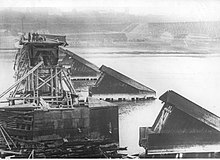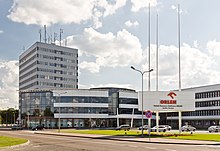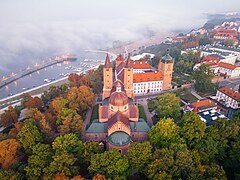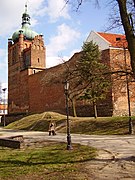Płock
Płock | ||
|---|---|---|
| Stołeczne Książęce Miasto Płock Ducal Capital City of Płock | ||
|
Car plates WP | | |
| Website | Płock City Hall | |
Płock (pronounced
Płock is a capital of the
History
Middle Ages

The area was long inhabited by pagan peoples. In the 10th century, a
During the rule of the first monarchs of the

In 1237 Płock was officially granted
Modern era

In the early modern period, Płock was a
In the 17th century, the Swedes destroyed much of the city, but the people rebuilt and recovered.[5] In the late 18th century, it took down the old city walls, and made a New Town, and after Germans of Prussia partitioned Poland Second Partition of Poland, they filled Plock with many German migrants.[5]
In the

During
World War II

Germany invaded Poland in September 1939, the city of Płock was annexed into the Reich as part of the Regierungsbezirk Zichenau. The Germans renamed the city Schröttersburg in 1941 after the former Prussian Baron of the Empire Friedrich Leopold von Schrötter.[14]
As part of the Intelligenzaktion, Germans carried out mass arrests of Poles, who were then imprisoned in the local prison, and around 200 of whom were murdered in large massacres in Łąck between October 1939 and February 1940.[15] Among the victims were Polish teachers, activists, shopowners, notaries, local officials, pharmacists, directors and members of the Polish Military Organisation.[16] Next mass arrests of about 2,000 Poles from Płock and the Płock County were carried out in April 1940, and in June 1940, another 200 Poles from various settlements in the region were imprisoned in the local prison.[17] Some prisoners were then deported and murdered in the Soldau concentration camp, and some teachers from Płock were among Polish teachers murdered in the Mauthausen concentration camp.[18] In 1940, Germans murdered 80 elderly and disabled people from Płock in the nearby village of Brwilno.[19] The Archbishop of Płock Antoni Julian Nowowiejski and the auxiliary Bishop Leon Wetmański were imprisoned in the nearby village of Słupno, and then in 1941 also murdered in the Soldau concentration camp, where also many other local priests were killed.[20] Nowowiejski and Wetmański are now considered two of the 108 Blessed Polish Martyrs of World War II by the Catholic Church. Poles were also subjected to expulsions, 1,300 Poles were expelled in November and December 1939, and over 4,000 also in February and March 1941.[21] Nazi Germany also subjected the inhabitants to forced labour. Even 10 to 14-year-old children were used for forced labour in the city and its environs, whereas older ones were deported to forced labour in Germany.[22] The Germans also established and operated two forced labour subcamps of the local prison,[23][24] and an additional forced labour "education" camp in the city.[25] In the winter of 1942–1943, a freight train with kidnapped Polish children arrived to the Płock-Radziwie station, and around 300 of the children froze to death and were buried by the Germans in the forests of nearby Łąck.[26] Since 1943, the local Sicherheitspolizei carried out deportations of Poles including teenage boys to the Stutthof concentration camp.[27]
| Year | Pop. | ±% |
|---|---|---|
| 1950 | 33,128 | — |
| 1960 | 42,798 | +29.2% |
| 1970 | 71,900 | +68.0% |
| 1980 | 102,548 | +42.6% |
| 1990 | 123,398 | +20.3% |
| 2000 | 128,580 | +4.2% |
| 2010 | 126,061 | −2.0% |
| 2020 | 118,268 | −6.2% |
| source [28] | ||
At the same time, the Nazis were also brutalizing the Jewish population of Płock. They conscripted them for forced labor and established a
Germans closed Polish institutions, schools
Despite such circumstances, the city remained the center of the
Recent history
In 1975–1998, Płock was the capital of the
Climate
Płock has an oceanic climate (Köppen climate classification: Cfb) using the −3 °C (27 °F) isotherm or a humid continental climate (Köppen climate classification: Dfb) using the 0 °C (32 °F) isotherm.[34][35]
| Climate data for Płock (1991–2020 normals, extremes 1951–present) | |||||||||||||
|---|---|---|---|---|---|---|---|---|---|---|---|---|---|
| Month | Jan | Feb | Mar | Apr | May | Jun | Jul | Aug | Sep | Oct | Nov | Dec | Year |
| Record high °C (°F) | 12.7 (54.9) |
16.5 (61.7) |
23.8 (74.8) |
30.3 (86.5) |
32.1 (89.8) |
34.3 (93.7) |
36.6 (97.9) |
37.3 (99.1) |
35.5 (95.9) |
26.7 (80.1) |
19.5 (67.1) |
15.4 (59.7) |
37.3 (99.1) |
| Mean daily maximum °C (°F) | 0.9 (33.6) |
2.5 (36.5) |
7.1 (44.8) |
14.1 (57.4) |
19.2 (66.6) |
22.3 (72.1) |
24.7 (76.5) |
24.6 (76.3) |
19.0 (66.2) |
12.7 (54.9) |
6.3 (43.3) |
2.3 (36.1) |
13.0 (55.4) |
| Daily mean °C (°F) | −1.4 (29.5) |
−0.4 (31.3) |
3.1 (37.6) |
8.8 (47.8) |
13.7 (56.7) |
16.9 (62.4) |
19.0 (66.2) |
18.8 (65.8) |
13.9 (57.0) |
8.7 (47.7) |
3.9 (39.0) |
0.1 (32.2) |
8.8 (47.8) |
| Mean daily minimum °C (°F) | −3.8 (25.2) |
−3.0 (26.6) |
−0.3 (31.5) |
3.9 (39.0) |
8.4 (47.1) |
11.6 (52.9) |
13.6 (56.5) |
13.5 (56.3) |
9.5 (49.1) |
5.4 (41.7) |
1.6 (34.9) |
−2.2 (28.0) |
4.9 (40.8) |
| Record low °C (°F) | −35.6 (−32.1) |
−27.7 (−17.9) |
−23.7 (−10.7) |
−6.2 (20.8) |
−4.0 (24.8) |
0.3 (32.5) |
4.2 (39.6) |
3.9 (39.0) |
−2.2 (28.0) |
−7.5 (18.5) |
−20.2 (−4.4) |
−23.9 (−11.0) |
−35.6 (−32.1) |
| Average precipitation mm (inches) | 30.4 (1.20) |
26.2 (1.03) |
30.6 (1.20) |
31.6 (1.24) |
50.8 (2.00) |
48.2 (1.90) |
40.5 (1.59) |
42.9 (1.69) |
47.3 (1.86) |
35.0 (1.38) |
33.7 (1.33) |
33.4 (1.31) |
450.7 (17.74) |
| Average extreme snow depth cm (inches) | 6.3 (2.5) |
5.9 (2.3) |
3.9 (1.5) |
1.0 (0.4) |
0.0 (0.0) |
0.0 (0.0) |
0.0 (0.0) |
0.0 (0.0) |
0.0 (0.0) |
0.3 (0.1) |
1.7 (0.7) |
3.7 (1.5) |
6.3 (2.5) |
| Average precipitation days (≥ 0.1 mm) | 15.62 | 13.77 | 13.20 | 11.40 | 12.37 | 12.40 | 13.13 | 12.30 | 11.50 | 12.80 | 14.60 | 15.90 | 158.99 |
| Average snowy days (≥ 0 cm) | 15.3 | 14.1 | 6.8 | 0.5 | 0.0 | 0.0 | 0.0 | 0.0 | 0.0 | 0.2 | 3.4 | 11.8 | 52.1 |
| Average relative humidity (%)
|
86.7 | 83.5 | 77.4 | 69.2 | 70.0 | 71.7 | 72.0 | 70.9 | 77.6 | 83.1 | 88.5 | 88.4 | 78.3 |
| Mean monthly sunshine hours | 48.9 | 68.8 | 132.3 | 203.8 | 254.8 | 256.9 | 257.9 | 247.0 | 166.5 | 111.2 | 47.3 | 36.4 | 1,831.7 |
| Source 1: Institute of Meteorology and Water Management[36][37][38][39][40][41][42][43] | |||||||||||||
| Source 2: Meteomodel.pl (records, relative humidity 1991–2020)[44][45][46] | |||||||||||||
Culture
Architecture
Main sights include:
- Płock Cathedral - originally built in the Romanesque style, dates back to the 12th century, reconstructed in 16th century
- Płock Castle, built in 14th century, today housing the diocesan museum with the collection of medieval goldsmiths' works
- Saint Dominic Church - former Dominican church, built in 13th century and remodelled in 16th century
- Saint Bartholomew Church - built in the 14th century, rebuilt in Baroque style in 18th century
- Small Synagogue - built 1810-1822
- Płock Town Hall, built 1824-1827 in the classicist style
- Neo-Gothicstyle
- Museum of Mazovia - housed in Art Nouveau tenement house
- Dom Turysty - modernist hotel built 1959-1962
-
Saint Dominic Church
-
Saint Bartholomew Church
-
Mariavite Temple of Mercy and Charity
Museums
- Diocesan Museum - located in the Płock Castle
- Museum of Masovia - provides exhibits and interpretation of the city and region's history
- The Museum of Mazovian Jews - housed in the former Small Synagogue
- Saint Faustina Museum - museum of Saint Faustina Kowalska
- Małachowianka Museum - museum of the Marshal Stanisław Małachowski High School
In popular culture
Various Polish films were shot in Płock, including
Cuisine
The officially protected
Religion
Catholic Church

Płock is the oldest legislated seat of the Roman Catholic
Moreover, the city is famous for the Divine Mercy Sanctuary, where the apparition of Jesus to Saint Faustina Kowalska is reported to have taken place, and the Divine Mercy devotion was revealed.[50]
Mariavite Church

From the visions of
Jewish history
The Jewish presence in Płock (Yiddish: Plotzk) dates back many centuries, probably to the 13th and 14th centuries, when records include them. The Polish kings extended rights to them in 1264 and the 14th century, and provided continued political support through the centuries.[51] At the beginning of the 19th century, their more than 1,200 residents comprised more than 48% of the city's population in what is considered the city's Old Town; through the century, their proportions ranged from 30 and 40 percent.[52] It varied as German migrants were arriving in the region, and the area was becoming urbanized, as more people moved to the city. After Płock fell to Russia in the 19th century, it was part of the Pale of Settlement, where Russians allowed the settlement of Jews. As in other parts of the Russian Partition of Poland, they were restricted to employment in trades and crafts.[51]

In the late 19th century, Moszek Szlama Sarna (1838–1908) established two factories to produce farm machines and tools, and the first iron foundry in the city. The Jewish community had two synagogues and two cemeteries (dating to the 15th century), religious and secular schools, and established a library and hospital. They contributed strongly to the economy and culture of the city. In the early 20th century,and had two newspapers, representing active political parties.[51]
In 1939, Płock had a Jewish population of 9,000, an estimated 26% of the city's total.[52] After the 1939 invasion of Poland, German Nazi persecution began, about 2,000 Jews fled the city, with half going to Soviet-controlled territory. They were assigned to locations far from the front. In 1940, the Nazis established a ghetto in Płock. They started actions against the Jews, killing those in an old people's home and sick children, and transporting others to be killed at Brwilski Forest. Ultimately, they transported the Jews to 20 camps and sites in the Radom district, where in 1942 those still alive were sent to Treblinka to be murdered.[51] There is evidence that a few Poles tried to help their Jewish neighbors in Plock by smuggling food into the ghetto, sneaking food to them while they were awaiting deportation, and throwing loaves of bread to them on the transport trucks. While small acts, they took courage.[53] By 1946, only 300 Jews survived in Płock. While they were active in the new politics, gradually the Jews left, and by 1959 three remained.[52] Herman Kruk, a survivor and notable chronicler of life inside the Nazi concentration camps, was born in Płock in 1897.[54]
The small synagogue, built in 1810, was one of the few to survive World War II in the Masovia region of Poland. The Great Synagogue was destroyed during the Holocaust. The small synagogue was designated as a historic building about 1960, but deteriorated in physical condition while vacant. It was renovated and adapted for use as a museum, opening in April 2013 as the Museum of Masovian Jews, a branch of the Museum of Płock Mazowiecki.[55]
Economy

The main industry is
Education
- Szkoła Wyższa im. Pawła Włodkowica
- Akademia Mazowiecka w Płocku
- Płock Campus of Warsaw University of Technology
- LO im. Marszałka Stanisława Małachowskiego w Płocku - the oldest school in Poland, dating back to 1180[8]
- LO im. Wladysława Jagiełły w Płocku
- III LO im. Marii Dąbrowskiej w Płocku
- IV LO im. Bolesława Krzywoustego w Płocku
Transport
Mass transit
- KM Płock - Komunikacja Miejska Płock[56]
Bus service covers the entire city, with 41 routes.
Bridges
Sport

- Superliga, Poland's top division, multiple Polish Champion and multiple Polish Cup winner
- Polish SuperCupwinner in 2006
Politics

Members of Parliament (Sejm) elected from Płock constituency
- Julia Pitera, PO
- Mirosław Koźlakiewicz, PO
- Andrzej Nowakowski, PO
- Wojciech Jasiński, Pis
- Marek Opioła, Pis
- Robert Kołakowski, Pis
- Dariusz Kaczanowski, Pis
- Waldemar Pawlak, PSL
- Adam Struzik, PSL
- plane crash 10 April 2010)
Notable people

- Bolesław III Wrymouth (1086–1138), Duke of Poland
- Aryeh Leib ben Moses Zuenz (c. 1768–1833) The Plocker Gaon, or Genius of Plock - noted Hasidic scholar.
- Józef Pius Dziekoński (1844–1924), architect and heritage conservator
- Kazimierz Zalewski (1849–1919), dramatist, literary and theatre critic
- Marxistanthropologist, economist and sociologist
- Edward Flatau (1868–1932), neurologist and psychiatrist
- Władysław Broniewski (1897–1962), poet, writer, translator and soldier
- Stefan Themerson (1910–1988), writer of children's literature, poet and novelist
- Jerzy Pniewski (1913–1989), physicist
- Rozka Korczak (1921–1988), partisan leader during World War II
- Włodzimierz Brus (1921–2007), economist and politician
- Righteous among the Nations
- Anna Kochanowska (1922–2019), radio journalist, literary director and politician
- Ryszard Syski (1924–2007), Polish-American mathematician
- Solidarity movement, and the first non-communist Polish prime ministersince 1946
- Wojciech Jankowski (born 1963), rower and Olympic medallist
- Ireneusz Czop (born 1968), actor
- Michał Łogosz (born 1977), badminton player
- Szymon Marciniak (born 1981), football referee
- Piotr Więcek (born 1990), drifting driver
- Kamil Syprzak (born 1991), handball player
- Paweł Halaba (born 1995), volleyball player
- Bartosz Kwolek (born 1997), volleyball player, 2018 World Champion
- Marcin Bułka (born 1999), goalkeeper
Twin towns - sister cities
Płock is
Former twin towns:
 Novopolotsk, Belarus (since 1996 until 2022)
Novopolotsk, Belarus (since 1996 until 2022) Mytishchi in Russia (since 2006 until 2022)
Mytishchi in Russia (since 2006 until 2022)
In March 2022, Płock suspended its partnership with the Russian city of Mytishchi and the Belarusian city of Novopolotsk as a response to the
See also
- Duke Capital City of Płock
- New Holland Agriculture
References
- ^ a b "Local Data Bank". Statistics Poland. Retrieved 7 August 2022. Data for territorial unit 1462000.
- ^ (in Polish)(Statut Miasta Płocka) Załącznik do Uchwały Nr 302/XXI/08 Rady Miasta Płocka z dnia 26 lutego 2008 roku (Dz. Urz. Woj. Mazowieckiego z 2008 r. Nr 91, poz. 3271 Archived 20 October 2011 at the Wayback Machine)
- ^ Rozporządzenie Prezydenta Rzeczypospolitej Polskiej z dnia 20 kwietnia 2018 r. w sprawie uznania za pomnik historii "Płock - Wzgórze Tumskie", Dz. U. z 2018 r. poz. 1003
- ^ a b Adolf Pawiński, Mazowsze, Warszawa 1895, p. 37 (in Polish)
- ^ a b c d Płock : Local History Archived 13 December 2014 at the Wayback Machine, Virtual Shtetl website, accessed 28 October 2013
- ^ a b c d e f g h i "Płock". Encyklopedia PWN (in Polish). Retrieved 11 July 2020.
- ^ "Get to know Płock". From official Płock website.en. Retrieved 17 February 2011.
- ^ a b c d e f g h i j "Z dziejów Płocka". Małachowianka OnLine (in Polish). Retrieved 1 September 2019.
- ^ Erlich, Ludwik (1968). Pisma wybrane Pawła Włodkowica (Preface). Warsaw: PAX. p. 13.
- ISSN 0860-1054.
- ^ Gembarzewski, Bronisław (1925). Rodowody pułków polskich i oddziałów równorzędnych od r. 1717 do r. 1831 (in Polish). Warszawa: Towarzystwo Wiedzy Wojskowej. p. 54.
- ^ Gembarzewski, p. 75
- ^ a b c "Rocznica odznaczenia Płocka Krzyżem Walecznych za obronę przed bolszewikami". Onet (in Polish). 8 April 2016. Retrieved 6 November 2020.
- ^ de:Landkreis Schröttersburg
- ^ Wardzyńska, Maria (2009). Był rok 1939. Operacja niemieckiej policji bezpieczeństwa w Polsce. Intelligenzaktion (in Polish). Warszawa: IPN. pp. 224–225.
- ^ Wardzyńska, Maria (2009). Był rok 1939. Operacja niemieckiej policji bezpieczeństwa w Polsce. Intelligenzaktion. pp. 225–226.
- ^ Wardzyńska, Maria (2009). Był rok 1939. Operacja niemieckiej policji bezpieczeństwa w Polsce. Intelligenzaktion. p. 230.
- ^ Wardzyńska, Maria (2009). Był rok 1939. Operacja niemieckiej policji bezpieczeństwa w Polsce. Intelligenzaktion. pp. 231–232.
- ^ Wardzyńska, Maria (2009). Był rok 1939. Operacja niemieckiej policji bezpieczeństwa w Polsce. Intelligenzaktion. p. 236.
- ^ Wardzyńska, Maria (2009). Był rok 1939. Operacja niemieckiej policji bezpieczeństwa w Polsce. Intelligenzaktion. p. 233.
- ISBN 978-83-8098-174-4.
- ^ ISSN 0029-389X.
- ^ "Außenkommando "Große Allee" des Strafgefängnisses Schröttersburg". Bundesarchiv.de (in German). Retrieved 6 November 2020.
- ^ "Außenkommando des Strafgefängnisses Schröttersburg in Bauzug". Bundesarchiv.de (in German). Retrieved 6 November 2020.
- ^ "Arbeitserziehungslager Schröttersburg-Süd". Bundesarchiv.de (in German). Retrieved 30 May 2021.
- Biblioteka Jagiellońska. p. 78.
- ^ Drywa, Danuta (2020). "Germanizacja dzieci i młodzieży polskiej na Pomorzu Gdańskim z uwzględnieniem roli obozu koncentracyjnego Stutthof". In Kostkiewicz, Janina (ed.). Zbrodnia bez kary... Eksterminacja i cierpienie polskich dzieci pod okupacją niemiecką (1939–1945) (in Polish). Kraków: Uniwersytet Jagielloński, Biblioteka Jagiellońska. p. 187.
- ^ "Płock (Mazowieckie) » mapy, nieruchomości, GUS, noclegi, szkoły, regon, atrakcje, kody pocztowe, wypadki drogowe, bezrobocie, wynagrodzenie, zarobki, tabele, edukacja, demografia".
- ISBN 978-0-253-35599-7.
- ^ a b Wardzyńska, Maria (2017). Wysiedlenia ludności polskiej z okupowanych ziem polskich włączonych do III Rzeszy w latach 1939-1945. p. 381.
- ^ a b Wardzyńska, Maria (2009). Był rok 1939. Operacja niemieckiej policji bezpieczeństwa w Polsce. Intelligenzaktion. p. 224.
- ^ "Widziałam egzekucję jako dziecko [FOTO]". PortalPłock (in Polish). Retrieved 1 July 2020.
- ISSN 0029-389X.
- .
- ISSN 1027-5606.
- ^ "Średnia dobowa temperatura powietrza". Normy klimatyczne 1991-2020 (in Polish). Institute of Meteorology and Water Management. Archived from the original on 3 December 2021. Retrieved 5 February 2022.
- ^ "Średnia minimalna temperatura powietrza". Normy klimatyczne 1991-2020 (in Polish). Institute of Meteorology and Water Management. Archived from the original on 15 January 2022. Retrieved 5 February 2022.
- ^ "Średnia maksymalna temperatura powietrza". Normy klimatyczne 1991-2020 (in Polish). Institute of Meteorology and Water Management. Archived from the original on 15 January 2022. Retrieved 5 February 2022.
- ^ "Miesięczna suma opadu". Normy klimatyczne 1991-2020 (in Polish). Institute of Meteorology and Water Management. Archived from the original on 9 January 2022. Retrieved 5 February 2022.
- ^ "Liczba dni z opadem >= 0,1 mm". Normy klimatyczne 1991-2020 (in Polish). Institute of Meteorology and Water Management. Archived from the original on 15 January 2022. Retrieved 5 February 2022.
- ^ "Średnia grubość pokrywy śnieżnej". Normy klimatyczne 1991-2020 (in Polish). Institute of Meteorology and Water Management. Archived from the original on 15 January 2022. Retrieved 5 February 2022.
- ^ "Liczba dni z pokrywą śnieżna > 0 cm". Normy klimatyczne 1991-2020 (in Polish). Institute of Meteorology and Water Management. Archived from the original on 21 January 2022. Retrieved 5 February 2022.
- ^ "Średnia suma usłonecznienia (h)". Normy klimatyczne 1991-2020 (in Polish). Institute of Meteorology and Water Management. Archived from the original on 15 January 2022. Retrieved 5 February 2022.
- ^ "Płock Absolutna temperatura maksymalna" (in Polish). Meteomodel.pl. 6 April 2018. Retrieved 5 February 2022.
- ^ "Płock Absolutna temperatura minimalna" (in Polish). Meteomodel.pl. 6 April 2018. Retrieved 5 February 2022.
- ^ "Płock Średnia wilgotność" (in Polish). Meteomodel.pl. 6 April 2018. Retrieved 5 February 2022.
- ^ "Jak kręcili filmy w Płocku, kto kogo uderzył w twarz i dlaczego". PortalPłock (in Polish). Retrieved 11 July 2020.
- ^ "Kiełbasa tumska". Ministerstwo Rolnictwa i Rozwoju Wsi - Portal Gov.pl (in Polish). Retrieved 30 May 2021.
- ^ "Baleron płocki". Ministerstwo Rolnictwa i Rozwoju Wsi - Portal Gov.pl (in Polish). Retrieved 30 May 2021.
- ^ Shrine of the Divine Mercy in Plock
- ^ a b c d Plock: Jewish Community before 1989 Archived 13 December 2014 at the Wayback Machine, Virtual Shtetl, accessed 28 October 2013
- ^ a b c Płock: Demography Archived 13 December 2014 at the Wayback Machine, Virtual Shtetl, accessed 28 October 2013
- ISBN 978-0-253-35599-7.
- ^ Kassow, Samuel D. "Vilna Stories". Retrieved 31 December 2012.
- ^ Samuel D. Gruber, "Poland: Płock Synagogue Reopens as a Museum", Samuel Gruber's Jewish Art and Monuments blog, accessed 28 October 2013
- ^ kmplock.eu
- ^ Mostwplocku.blogspot.com
- ^ "Miasta partnerskie". Retrieved 18 May 2020.
- ^ "Städtepartnerschaften und Internationales". Büro für Städtepartnerschaften und internationale Beziehungen (in German). Archived from the original on 23 July 2013. Retrieved 26 July 2013.
- ^ "Płock zawiesza partnerską współpracę z rosyjskimi i białoruskimi miastami" (in Polish). 2 March 2022. Retrieved 13 March 2022.








